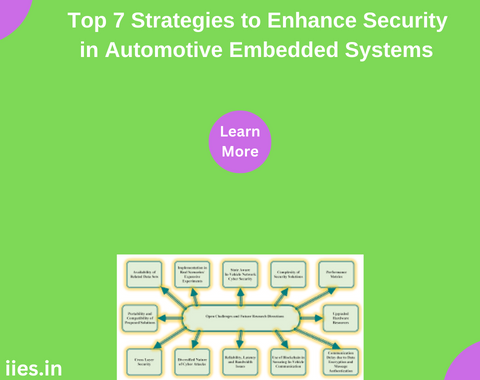
The automotive industry is undergoing a technological revolution, and at the heart of this transformation lies embedded systems. These intricate systems play a crucial role in modern vehicles, enabling a myriad of features such as advanced driver assistance systems (ADAS), infotainment, engine control, and more. As automotive embedded systems become increasingly complex, developers face a multitude of challenges that demand innovative solutions. In this article, we delve into the key challenges encountered by automotive embedded system developers and explore the strategies they employ to overcome these hurdles.
To address this, developers are increasingly adopting model-based design approaches and simulation tools to identify and rectify safety-related issues early in the development process. Additionally, the use of redundant systems and fail-safe mechanisms becomes crucial to meet safety standards.
One of the foremost challenges for automotive embedded system developers is adhering to stringent safety standards and regulations. As vehicles become more autonomous and interconnected, ensuring the safety and security of embedded systems becomes paramount. Compliance with standards such as ISO 26262, which focuses on functional safety, requires developers to implement rigorous testing and validation processes throughout the development lifecycle. This not only increases development time but also poses challenges in terms of resource allocation and cost management.
Integration of Advanced Technologies:
The integration of advanced technologies like artificial intelligence (AI), machine learning (ML), and connectivity features adds another layer of complexity for automotive embedded system developers. Incorporating these technologies demands specialized skills and a deep understanding of both hardware and software aspects. AI and ML algorithms, in particular, require extensive data sets for training, necessitating the development of robust data acquisition and processing strategies.
Moreover, as vehicles become more connected, developers face the challenge of ensuring seamless communication between various embedded systems. The integration of complex software stacks, including operating systems, middleware, and applications, requires meticulous planning and execution to prevent performance bottlenecks and compatibility issues.
Real-time Processing Requirements:
Automotive applications, especially those related to safety and control systems, demand real-time processing capabilities. Developers must contend with the challenge of meeting stringent timing constraints to ensure that critical functions operate without latency. Achieving real-time performance requires optimization at both the hardware and software levels.
To overcome this challenge, developers often employ hardware acceleration techniques, use specialized processors, and fine-tune software algorithms for efficiency. Additionally, the adoption of multicore architectures allows for parallel processing, enabling better handling of multiple tasks simultaneously.
Increasing Complexity of Embedded Software:
The functionality of modern vehicles heavily relies on sophisticated embedded software, leading to a substantial increase in code complexity. This complexity poses challenges in terms of code maintainability, debugging, and the overall development process. Managing large codebases becomes a significant concern, making it essential for developers to adopt effective coding practices and tools.
To address this challenge, many developers turn to model-driven development approaches and automated code generation tools. These tools help streamline the software development process, reduce manual errors, and enhance code quality. Additionally, the use of modular and scalable architectures allows for easier maintenance and updates.
Cybersecurity Threats:
As vehicles become more connected and reliant on digital communication, the threat of cybersecurity breaches becomes a critical concern for embedded system developers. Ensuring the security of in-vehicle networks, communication protocols, and software components is essential to safeguard against malicious attacks. The automotive industry faces the challenge of staying one step ahead of cyber threats that continuously evolve in sophistication.
To mitigate cybersecurity risks, developers implement robust security protocols, encryption algorithms, and intrusion detection systems. Regular security audits and updates are crucial to addressing vulnerabilities and enhancing the overall cybersecurity posture of embedded systems.
Supply Chain Disruptions:
Global supply chain disruptions, as witnessed in recent times, present a significant challenge for automotive embedded system developers. Shortages of critical components, such as semiconductors, can lead to delays in production and impact the timely release of vehicles with advanced embedded systems. Developers must navigate through uncertainties in the supply chain, diversify suppliers, and adopt agile strategies to adapt to changing circumstances.
To mitigate the impact of supply chain disruptions, developers explore options such as inventory management, alternative sourcing, and collaboration with suppliers for contingency planning. Additionally, the adoption of flexible design approaches that allow for the substitution of components helps in minimizing the impact of supply chain uncertainties.
Automotive embedded system developers face a myriad of challenges as they strive to keep pace with the rapidly evolving automotive landscape. From stringent safety standards to the integration of cutting-edge technologies, each hurdle demands a strategic and innovative approach. The continuous pursuit of efficiency, adaptability, and security is crucial for developers aiming to create embedded systems that not only meet current requirements but also pave the way for the future of connected and autonomous vehicles. As the automotive industry progresses, overcoming these challenges will be instrumental in shaping a safer, more efficient, and technologically advanced driving experience.
Indian Institute of Embedded Systems – IIES